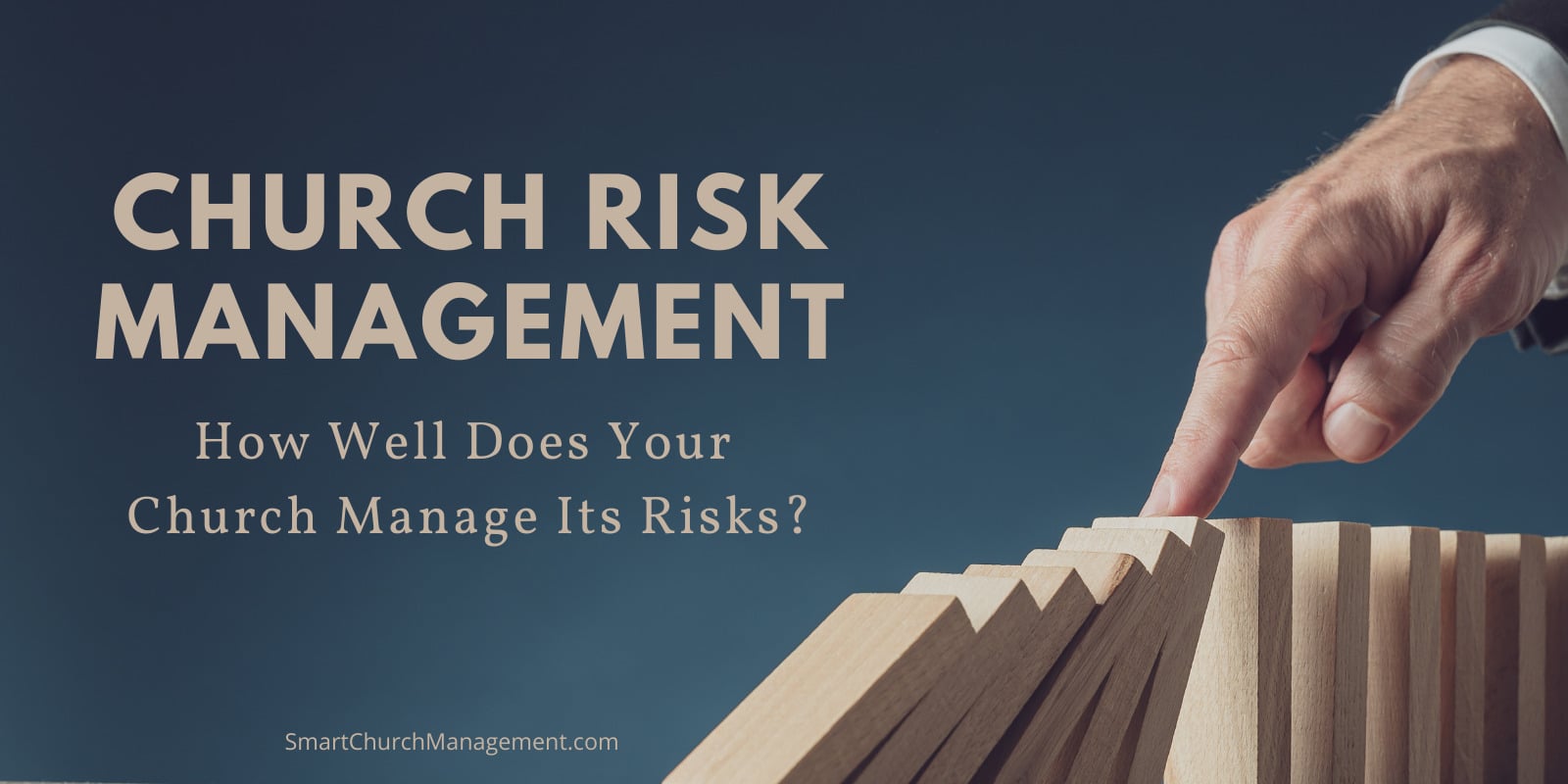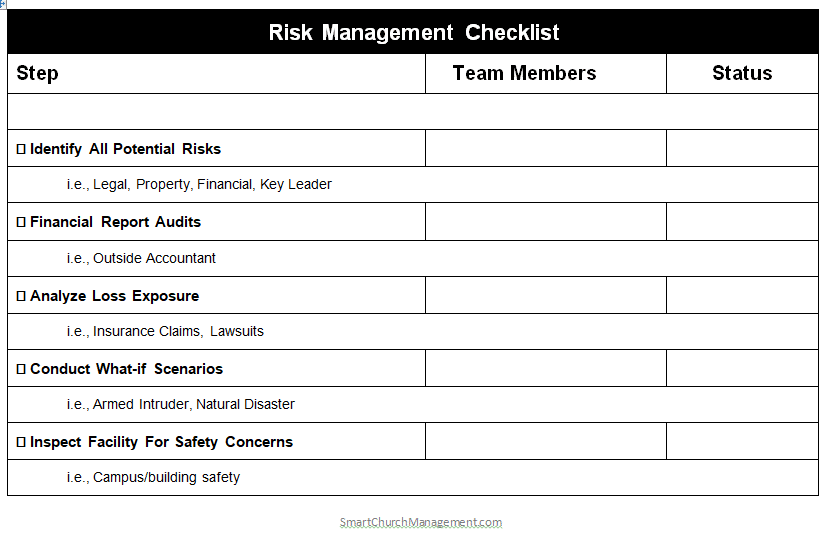Estimated reading time: 6 minutes
Church Risk Management. We have all heard the term, and each has a slightly different interpretation of the phrase.
We all encounter risks in our personal lives. We have risks when we get in the car to go to the grocery store.
There is a risk in walking on a snow-covered sidewalk. There is a risk with leaving our front door unlocked and so on.
Management of risk is something we learn to do at a young age. We learn as a child to lock the car door.
We invest in insurance in case we have a car accident, house fire, or need to go to the hospital.
We manage personal risk by purchasing insurance and proactively taking measures to reduce our risk and liability.
Risk is defined as (Exposure to) the possibility of loss, injury, or other adverse or unwelcome circumstance; a chance or situation involving such a possibility.
Church Risk Needs To Be Managed
Similar to our personal risk, churches have risks that need to be managed.
The first step in managing church risk is to make a list of all risks that your church may have.
To do this, identify a team of members and volunteers who represent all areas of ministry. For instance, you may want to include a children’s ministry worker to give a perspective on possible risks in dealing with kids.

Begin with a simple brainstorming session and use sticky notes to make a list.
Your list may include:
Legal Risk
- Employment laws. For instance, sexual misconduct, discriminatory practices, job classifications, etc.
- Accidents. Personal injury and safety on the church campus.
- Employee Injuries. Workman’s compensation for on-the-job injuries.
- Abuse of minors. Inappropriate interactions between an employee/volunteer with a minor child.
Church Property
- Vandalism. Churches are everywhere, and vandalism is a very real problem for some ministries.
- Building Maintenance. Churches need to be maintained, and church leaders need to be aware of building safety issues. For instance, if your church has a kitchen, when was the last time the grease trap was maintained and cleaned?
Church Finances
- Embezzlement. This is a difficult subject to talk about, but church embezzlement is a very real problem that churches deal with. Your church needs to be proactive in protecting its financial assets.
Unanticipated Emergency
- Natural Disaster: Flood, tornado, earthquake, hurricane.
- Fire. Building fire.
- Armed intruder. Church shootings have become more common.
Unexpected Departure of Key Leader
- Moral Failure. It is a sad fact, but there have been more than a couple of instances of church leaders who have fallen into the trap of moral failure.
- Failing Health. There are times when our health fails, and we can’t do what we once did. In the example of a key church leader, this can devastate a congregation.
- Sudden Death. It is difficult to imagine our leader dying suddenly from illness or an accident, but it is a very real risk for churches.

Church Risk Management Checklist
After you have your list of potential risks, use the following checklist to monitor your oversight commitment.
🗹 Financial Report Audits
For instance, hire an outside auditor to ensure that your internal practices are working to eliminate the possibility of stolen funds or property.
🗹 Analyze loss exposure
For instance, review any insurance claims, lawsuits, or fines/settlements the church has managed.
🗹 Conduct a “What-if” scenario.
For instance, emergency planning means to go through a process to think through how the church would respond to a natural disaster, armed intruder, or any other event that would be considered an emergency.
🗹 Inspect facility for safety concerns.
For instance, reach out to your insurance carrier and ask them to do a site inspection. They are familiar with risks, and they may identify facility safety issues that you may not be able to identify.
🗹 Safety and security audit.
For instance, utilize your security team to assess building safety before, during, and after church services and events.
🗹 Prioritize the risks.
For instance, think through which risk will impact the church and plan for that risk.
🗹 Envision the worst-case scenario.
For instance, ask yourself if your lead pastor was suddenly gone, what impact would that have on the church, its membership, and donations?
🗹 Assign a cost to each worst-case scenario.
For instance, what would the replacement and revenue costs be if your campus kitchen caught fire?
🗹 Identify replacement costs.
For instance, ask yourself, what the replacement costs would be for each worst-case and what will it take to offset those costs? For instance, would it make sense to carry a Key Person Insurance Policy for an irreplaceable leader?
🗹 Develop a plan to address each priority.
For instance, does your church have a succession plan for your key leadership? If not, now might be a good time to develop one.
🗹 Review plans at church board meetings.
For instance, add risk management to the agenda for all church board meetings to ensure work is done to address risk priorities.
Church Risk Is A Board Responsibility
A church board is responsible for overseeing and managing church risk. Make sure your board creates a risk management policy that defines the process for minimizing risk.
This oversight body needs to be aware of the need to assess and manage risk within the church.
The unfortunate reality is failures in the church are the direct result of leadership failing to identify, assess, and manage potential risk.
This includes failure to plan for the ‘what-if’ scenarios, failure to guard against embezzlement of church funds, or failure to run background checks on volunteers who work with kids.
Today might be the right time to gather your leadership and begin the process of assessing and managing your church risk. The best time to do this is always before an unexpected event happens.
How well does your church manage risk?
If you are an SCM member, you can access an editable Risk Management Checklist by logging in here. If you are not a member and would like access to our growing library of forms, documents, and job descriptions, click here.



